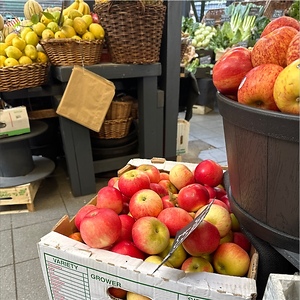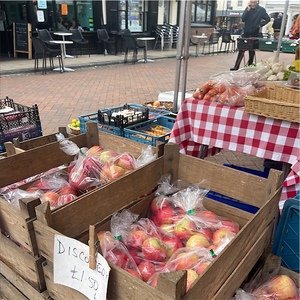


Discovery Apples
Estimated Inventory, 1 Lb : 0
Description/Taste
Discovery apples are a small to medium-sized variety, averaging 5 to 7 centimeters in diameter, and have a conical to round shape with a slightly flattened, irregular, and tapered appearance. The apple’s skin has a yellow-green base and is almost completely covered in bright red-orange to dark red blush with some spotting. Discovery apples also have a unique speckling and netting of russet, giving the surface a sandy, semi-rough and smooth texture. Underneath the skin, the white flesh is fine-grained, aqueous, and crisp, encasing a small central core filled with dark brown seeds. The flesh can also be flushed with a red-pink hue, a pigment transferred from the skin. Discovery apples have an acidic nature, creating a sweet and tangy flavor with refreshing, fruity, and honeyed nuances reminiscent of strawberries.
Seasons/Availability
Discovery apples are available in the late summer through fall.
Current Facts
Discovery apples, botanically classified as Malus domestica, are an early-season variety belonging to the Rosaceae family. The English apples were selected from a grouping of open-pollinated seedlings in the 1940s and were highly favored among growers and home gardeners for the fruit’s arrival at the beginning of the apple season. Discovery apples are also known as Thurston August and Dummer’s Pippin apples and were one of the most popular early-season apples in England during the 20th century. The cultivar is considered a fresh eating dessert apple, but many apple enthusiasts also use Discovery apples for several cooked preparations. In the modern-day, Discovery apples are commercially grown on a small scale and are a common home garden cultivar, planted for the tree’s compact size, prolific nature, and frost tolerance. Growers in the United Kingdom also use the variety to launch the English apple season.
Nutritional Value
Discovery apples are a source of fiber to regulate the digestive tract, potassium to balance fluid levels within the body, and vitamin C to strengthen the immune system, reduce inflammation, and boost collagen production. The apples also provide magnesium to maintain optimum nerve functioning, calcium and phosphorus to protect bones and teeth, and other amounts of vitamins A, E, and K, boron, iron, zinc, and copper.
Applications
Discovery apples have a sweet and tangy flavor well suited for fresh and cooked preparations. The apples have a crisp, fine-grained texture most popularly enjoyed straight, out of hand, and depending on when the apples are picked, they may contain a fruity, strawberry-like taste. Discovery apples can also be tossed into salads, mixed into fruit dishes, or chopped and used as a fresh topping over acai and grain bowls. In England, Discovery apples are frequently served chilled as a refreshing snack on warm days at the end of summer. They can also be blended into smoothies or pressed into a sweet juice. In addition to fresh preparations, Discovery apples can be cooked into a light, fluffy, and sweet puree. This puree can be incorporated into apple sauce, a typical side dish to roasted meats, or baked into cakes, muffins, bread, and other pastries. Discovery apples can also be sliced and cooked into tarts, hollowed, stuffed, and baked whole, or simmered in brown butter as a savory-sweet topping over ice cream. Discovery apples pair well with spices such as cinnamon, cloves, nutmeg, and ginger, vanilla, nuts including pecans, walnuts, and almonds, and meats such as poultry, pork, lamb, and turkey. Whole, unwashed Discovery apples have a short shelf life and will only keep up to one week when stored in the refrigerator. If kept longer than one week, the apples may develop a soft, unpleasant texture and flavor.
Ethnic/Cultural Info
Discovery apples symbolize perseverance as they arose from a group of seedlings created from worcester pearmain apples on a farm in Essex just after the end of World War II. Workman George Dummer selected the seedling for his home garden, and Dummer desired to plant the seedling in his front garden. Dummer only had one arm and requested that his wife help him move the seedling, but his wife suddenly suffered a freak accident and sprained her ankle, unable to move the tree. The Discovery apple seedling had to survive the winter and several frosts in its original location, solely covered by a bag, but despite the harsh climate, the seedling lived and eventually produced a large crop. The apple tree’s determination to survive caught the attention of Jack Mathews, a nurseryman who released new apple trees each year to promote his business. Mathews held a party under the apple tree to endorse the new variety and sent the Queen Mother apples on her birthday in August, contributing to the cultivar’s success as a recognized early-season English apple.
Geography/History
Discovery apples are native to Blacksmith’s Corner in the village of Langham, Essex, in England, and were first noticed in 1949. The variety was created from an open-pollinated cross of the worcester pearmain by George Dummer, a workman on an Essex fruit farm. Experts hypothesize that the other parent apple may have been the beauty of bath. Dummer raised a number of seedlings and selected one seedling to plant in his home garden. After hearing of the seedling’s resilience, nurseryman Jack Matthews of Thurston, Suffolk, purchased grafts from Dummer for propagation. Matthews was known for seeking out new varieties of apples and released a cultivar each year. The nurseryman cultivated the grafted branches on trees for several years and initially named the variety Thurston August in honor of his hometown and the apple’s early-ripening time in August. The cultivar was also sometimes known as Dummer’s Pippin apples. In 1962, the apple’s name was officially changed to Discovery and was released to the public for commercial cultivation. Discovery apples became one of the most famous early apple varieties in the United Kingdom by the 1970s and 1980s, and in 1993, the apple received the Award of Garden Merit by the Royal Horticultural Society. The mother apple tree is also still alive and growing in Langham, England. Today Discovery apples are commercially sold on a small scale in grocers, local markets, and farm stands throughout the United Kingdom. They are also grown in home gardens in the United Kingdom and British Columbia.
Recipe Ideas
Recipes that include Discovery Apples. One
| Olive |
|
Baked toffee apple cheesecake |
| Tastemade |
|
Stuffed Apple Cake |









